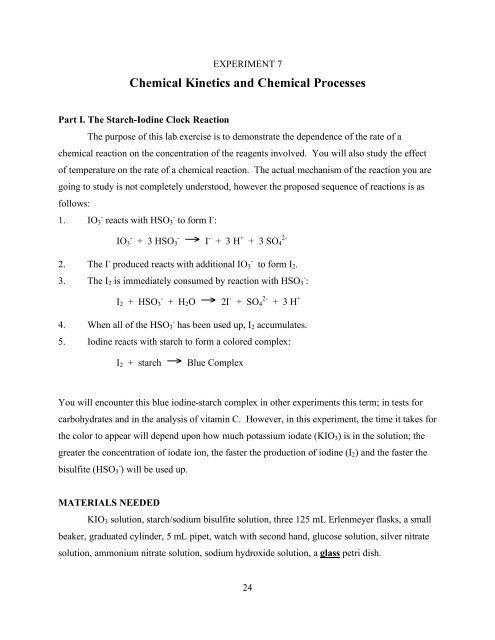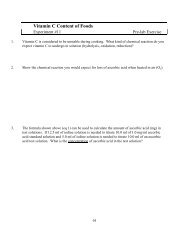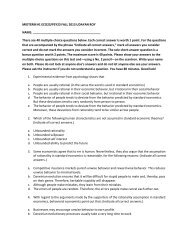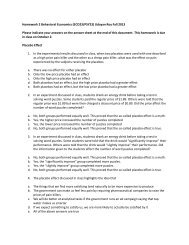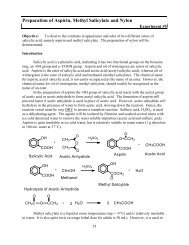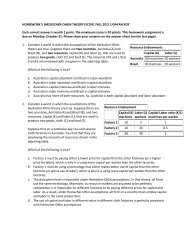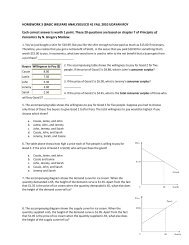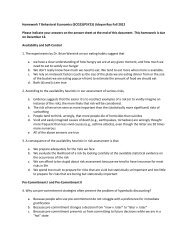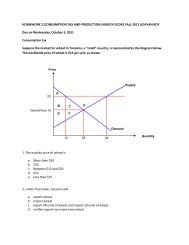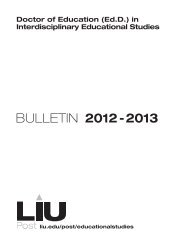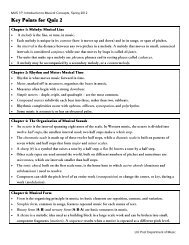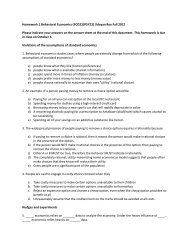Chemical Kinetics and Chemical Processes
Chemical Kinetics and Chemical Processes
Chemical Kinetics and Chemical Processes
Create successful ePaper yourself
Turn your PDF publications into a flip-book with our unique Google optimized e-Paper software.
EXPERIMENT 7<strong>Chemical</strong> <strong>Kinetics</strong> <strong>and</strong> <strong>Chemical</strong> <strong>Processes</strong>Part I. The Starch-Iodine Clock ReactionThe purpose of this lab exercise is to demonstrate the dependence of the rate of achemical reaction on the concentration of the reagents involved. You will also study the effectof temperature on the rate of a chemical reaction. The actual mechanism of the reaction you aregoing to study is not completely understood, however the proposed sequence of reactions is asfollows:1. IO - 3 reacts with HSO - 3 to form I - :IO 3-+ 3 HSO 3-→ I - + 3 H + + 3 SO 42-2. The I - produced reacts with additional IO 3-to form I 2 .3. The I 2 is immediately consumed by reaction with HSO 3 - :I 2 + HSO 3-+ H 2 O → 2I - + SO 42-+ 3 H +4. When all of the HSO 3 - has been used up, I 2 accumulates.5. Iodine reacts with starch to form a colored complex:I 2 + starch → Blue ComplexYou will encounter this blue iodine-starch complex in other experiments this term; in tests forcarbohydrates <strong>and</strong> in the analysis of vitamin C. However, in this experiment, the time it takes forthe color to appear will depend upon how much potassium iodate (KIO 3 ) is in the solution; thegreater the concentration of iodate ion, the faster the production of iodine (I 2 ) <strong>and</strong> the faster thebisulfite (HSO - 3 ) will be used up.MATERIALS NEEDEDKIO 3 solution, starch/sodium bisulfite solution, three 125 mL Erlenmeyer flasks, a smallbeaker, graduated cylinder, 5 mL pipet, watch with second h<strong>and</strong>, glucose solution, silver nitratesolution, ammonium nitrate solution, sodium hydroxide solution, a glass petri dish.24
Part B. Dependence of Reaction Rate on Temperature.Warm about 50 mL of water in a 400 mL beaker to 45 or 50 C. Place some ice in about50 mL of water in another 400 mL beaker. Clean the three 125 mL Erlenmeyer flasks <strong>and</strong> add20 mL potassium iodate solution to each flask, as you did for part A above. Place one of theseflasks in the warm water bath for several minutes to warm the iodate solution. Place another ofthe flasks in the ice water bath for several minutes to cool the iodate solution. Leave one of theflasks on the bench top to remain at room temperature. You should record the temperature of theroom, temperature of the warm water bath <strong>and</strong> temperature of the ice bath in your notebook (seetable below).ConditionTemperatureReaction TimeReaction TimeAverage( C)Trial 1Trial 2TimeIce WaterRoom TempWarm WaterAdd 20 mL of starch/sodium bisulfite solution to the flask at room temperature <strong>and</strong>record the time it takes for the color to change. After the reaction is complete, add 20 mL of26
starch/sodium bisulfite solution to the flask in the warm water bath <strong>and</strong> record the time for thecolor change. How does the time for the reaction in the warm flask compare with the reactiontime at room temperature? Finally, add 20 mL of starch/sodium bisulfite solution to the flask inthe ice water bath <strong>and</strong> record the time for the color change. How does this compare to thereaction at room temperature?Part 2. The Silver Mirror Reaction.In this part of the experiment you are going to make a silver mirror using a glass petridish. The chemical reaction that is involved is the reduction of silver ion (Ag + ) to silver metal(Ag ) by the sugar glucose (also known as dextrose). Any aldehyde will work for this reaction,but the reaction with a simple sugar is used to illustrate the reducing nature of a simple sugar.You will study the chemical properties of sugars in a later lab. The reduction of the silver ion tosilver metal also occurs in black <strong>and</strong> white photography, where the silver metal deposited in anemulsion on the film or paper gives rise to the black (or shades of grey) image.The chemical reaction taking place can be represented as follows:OORCH+ 2 Ag + (NH 3 ) 2 + H 2 O R C O -+ 2 Ag + NH 3 + 3 NH 4+PROCEDUREMake sure the glass petri dish is scrupulously clean (wash with detergent <strong>and</strong> rinse wellwith deionized water). This procedure does not work if there is any contamination of the glass,especially from chloride ions in tap water. Add 10 ml of sodium hydroxide (NaOH) solution tothe petri dish. In a small beaker or flask, mix 10 ml of glucose solution, 5 ml of silver nitrate(AgNO 3 ) solution <strong>and</strong> 5 ml of ammonium nitrate (NH 4 NO 3 ) solution. When they have beenmixed well by swirling the beaker, add it to the petri dish containing the 10 ml of NaOHsolution, ensuring that the solutions mix well in the dish. Allow the solution to remain in thepetri dish for about 10 minutes. You should see the silver mirror effect on the sides of the dish.Pour the solution from the petri dish into a beaker containing about 20 ml of 3 M HCl. Pour the27
contents of this waste beaker into the funnel on the waste bottle set up in the hood. Clean yourglassware well. You can keep the mirror you made if you desire.Questions to answer in your notebook:1. The relative concentration of potassium iodate in flask 2 compared to flask 1 is one-half.What is the ratio of the amount of time it takes for the reaction to occur? Is it also onehalf?Is it twice as much time? Is it four times longer?2. The ratio of iodate concentration in flask 3 compared to flask 2 is also one-half. The ratioof iodate concentration for flask 3 relative to flask 1 is one-quarter. What are the timeratios for these flasks? How does the ratio of times for the reaction compare to the ratioof concentration?3. What is the role of the starch in this reaction?4.* What conclusions would you make from this experiment regarding the effect oftemperature or the effect of concentration of a reagent on the rate of a chemical reaction?6. What is the role of glucose in the silver mirror reaction?7.* Describe what is happening when the silver becomes deposited on the glass to form amirror. How would you explain this to a friend who is not taking chemistry?28


